

Note-taking. President Jimmy Carter's Notes from his private meeting with Pope John Paul II, October 6, 1979.

Note-taking (sometimes written as notetaking or note taking) is the practice of recording information from different sources and platforms. By taking notes, the writer records the essence of the information, freeing their mind from having to recall everything.[1] Notes are commonly drawn from a transient source, such as an oral discussion at a meeting, or a lecture (notes of a meeting are usually called minutes), in which case the notes may be the only record of the event. History[edit] Note-taking has been an important part of human history and scientific development. The Ancient Greeks developed hypomnema, personal records on important subjects. Cognitive psychology[edit]
Strategies to Help Students ‘Go Deep’ When Reading Digitally. Students are doing more reading on digital devices than they ever have before.

Not only are many teachers using tablets and computers for classroom instruction, but many state tests are now administered on computers, adding incentive for teachers to teach digital reading strategies. But casual digital reading on the internet has instilled bad habits in many students, making it difficult for them to engage deeply with digital text in the same way they do when reading materials printed on paper. Devin Hess sympathizes with educators’ concerns, but believes digital reading is here to stay and teachers have a duty to equip students to engage with digital texts in meaningful ways. Hess was a middle school social studies teacher and early tech adopter in his classroom. Now he works with the UC Berkeley History-Social Science Project training social studies teachers on deep reading strategies. “I don’t believe technology should ever be taught separately,” Hess said.
6 Strategies for Taking High-Quality Notes. The good news is that teachers can show their students how to take better notes. Even better, good note-taking activities are themselves learning processes that can help students think metacognitively about their own studying, and can improve their retention of course material. A virtuous cycle! Six Powerful Note-Taking Strategies 1. Organize the blank page. Here’s a great way to guide your students to do that: Have them draw a line down each sheet of paper they’ll use, making two columns. After class is over, students should use the blank column to create questions or summaries about the material and use the questions and summaries to quiz themselves on the lecture notes. 7 Simple Note Taking Techniques for Efficient Learning. Whether you are going back to college or have decided to take learning into your own hands, note-taking is a skill that is truly unique.
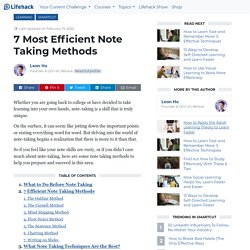
On the surface, it can seem like jotting down the important points or stating everything word for word.
Concept List - Kutztown University. 1Five_Methods_of_Notetaking.docx_UPDATED_7-09.pdf. Methods Of Note Taking. A.
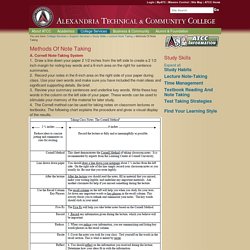
Cornell Note-Taking System Draw a line down your paper 2 1/2 inches from the left side to create a 2 1/2 inch margin for noting key words and a 6-inch area on the right for sentence summaries. Record your notes in the 6-inch area on the right side of your paper during class. Use your own words and make sure you have included the main ideas and significant supporting details. Be brief. Outlining Method. The outlining method is perhaps the most common form of note taking used by college students; an outline naturally organizes the information in a highly structured, logical manner, forming a skeleton of the textbook chapter or lecture subject that serves as an excellent study guide when preparing for tests.
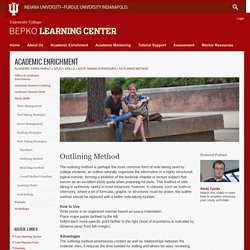
This method of note taking is extremely useful in most instances; however, in classes, such as math or chemistry, where a lot of formulas, graphs, or structures must be drawn, the outline method should be replaced with a better note-taking system. How to Use Write points in an organized manner based on space indentation. Place major points farthest to the left. Indent each more specific point farther to the right (level of importance is indicated by distance away from left margin). AdvantagesThe outlining method emphasizes content as well as relationships between the material. ExampleHow to study from an outline: I. Adapted from: Wong, L. (2006).
ASC Notetaking. Note Taking Systems - Academic Skills Center: Study Skills Library - Cal Poly, San Luis Obispo. The Cornell Method The Cornell method provides a systematic format for condensing and organizing notes without laborious recopying.
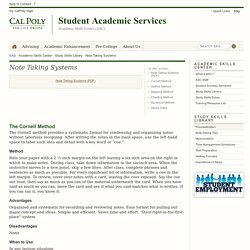
After writing the notes in the main space, use the left-hand space to label each idea and detail with a key word or "cue. " Cornell%20note%20taking%20system.pdf. The Learning Toolbox - Cornell Notes. Note Taking Techniques - Kutztown University. T-Notes Method for Note Taking - Kutztown University.
Top Ten Tips on Note-taking - Careers Advice. Note taking is a skill that we use in many walks of life: at school, university and in the world of work.
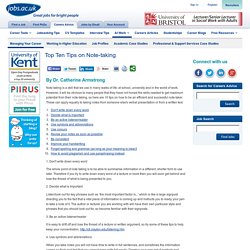
However, it will be obvious to many people that they have not honed the skills needed to get maximum potential from their note-taking, so here are 10 tips on how to be an efficient and successful note-taker. These can apply equally to taking notes from someone else's verbal presentation or from a written text. 1. Don't write down every word The whole point of note taking is to be able to summarise information in a different, shorter form to use later. 2. Listen/look out for key phrases such as ‘the most important factor is...' which is like a large signpost directing you to the fact that a vital piece of information is coming up and instructs you to ready your pen to take a note of it. 3.
It is easy to drift off and lose the thread of a lecture or written argument, so try some of these tips to help keep your concentration. 4. 5. How to do a Mind Map - JCU. Mind mapping (or concept mapping) involves writing down a central idea and thinking up new and related ideas which radiate out from the centre.
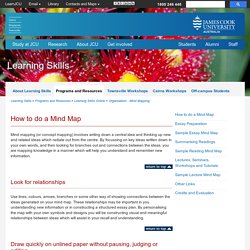
By focussing on key ideas written down in your own words, and then looking for branches out and connections between the ideas, you are mapping knowledge in a manner which will help you understand and remember new information. Look for relationships Use lines, colours, arrows, branches or some other way of showing connections between the ideas generated on your mind map. These relationships may be important in you understanding new information or in constructing a structured essay plan.
By personalising the map with your own symbols and designs you will be constructing visual and meaningful relationships between ideas which will assist in your recall and understanding. Draw quickly on unlined paper without pausing, judging or editing. Dysnotehowtomindmap.pdf. Bubbl.us - brainstorm and mind map online. Visual Understanding Environment.
Cornell_note_taking_151211.pdf. Note Taking Skills.